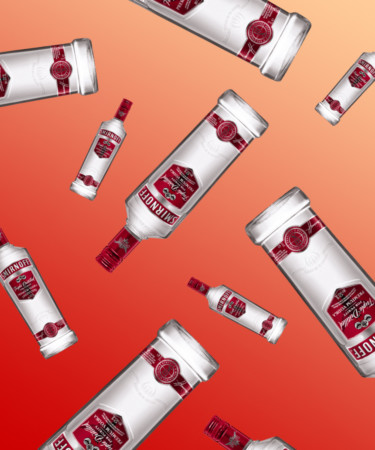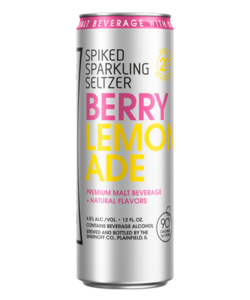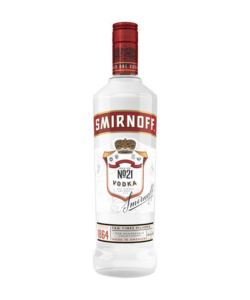For some, the thought of Smirnoff might conjure up a visceral and unwelcome memory of their head resting on a toilet seat — a byproduct of its reputation as a party-centric booze. But in fact, Smirnoff is a liquor to be taken seriously. It’s the top selling vodka in the world, making it a force to be reckoned with. The brand sold over 25.6 million nine-liter cases in 2019, a number that is unfathomable to even its closest competitors.
Even though you’re likely to find it at any frat party (or in the lyrics of any number of rap songs), Smirnoff has a notable global history. So before you go to the liquor store to pick up a bottle, read on for 16 things you should know about this vodka superpower.
There is a guy named Smirnoff — kind of.
Actually, his name is Pyotr Smirnov. He started out life as a Russian serf (basically at the bottom of a feudal totem pole) and went on to create the best-selling vodka in the world. When he died, he was worth $130 million and was one of the richest men in Russia. Sound familiar? Smirnov’s origin story is similar to that of the founder of Grey Goose vodka, who was born into a poor farming family and became a billionaire.
Smirnov was a marketing genius.
Smirnov started selling his vodka in 1864, but considering this was over a century before the invention of social media, he had to get creative with his marketing techniques. His solution: give panhandlers food and drink and in return, ask them to fan out around the city of Moscow demanding Smirnoff vodka. (It worked.)
Smirnov wanted to sell his vodka to the tsar.
The vodka producer wasn’t just looking to get everyday people tipsy. Smirnov wanted to earn the exclusive contract to supply vodka to the tsar of Russia at the time, Aleksandr III Aleksandrovich. And he did, in 1886. Next time you see someone wincing after a shot of Smirnoff, remind them they’re drinking the preferred libation of royalty.
Tolstoy and Chekhov tried to shut Smirnoff down.
When they weren’t busy writing literary masterpieces, these guys were out trying to find a way to take down the booze industry. In the late 19th Century, Leo Tolstoy and Anton Chekhov led an anti-alcohol campaign. Fortunately for Smirnoff drinkers, Pyotr’s son Vladimir Smirnov was able to escape the country and bring his vodka recipe with him to France.
Smirnoff’s spelling is a result of the Bolshevik revolution.
Since he ran a capitalist enterprise — and was selling booze, to boot — Vladimir Smirnov was forced to flee Russia after the Bolshevik revolution, resettling his base of operations in Europe. “Smirnoff” is the French spelling of the Russian vodka.
At one point, Russia was in charge of Smirnoff.
Before the Smirnovs fled Russia, there was a brief period in which the state took control of the business. (In theory it was to rein in corruption and alcoholism, but it did end up making the country hundreds of millions of dollars).
Smirnoff is gluten-free.
Well, the unflavored version is. The “natural flavorings” in the flavored versions might contain trace amounts of gluten, but Smirnoff vodka is made from corn, making it totally gluten-free.
Smirnoff is charcoal-filtered.
Which is the same thing they do to the bourbon that becomes “Tennessee Whiskey.” Charcoal filtration is thought to mellow a spirit by removing further impurities. Smirnoff is also triple-distilled, although there’s no real evidence that the number of times vodka is distilled impacts its purity or quality.
There are 33 currently marketed flavors of Smirnoff.
The brand offers everything from a commonplace Raspberry flavor, to gimmicky Whipped Cream. Don’t worry Smirnoff, we’re pretty sure that one’s burned into our brains forever. Sure, we’ve all seen fruit flavored vodka. But what about “Root Beer Float”? We’re terrified, but intrigued.
Those crazy flavors are consumed all over the world
Today, over 150 years after the brand was created, Smirnoff vodka is sold in 130 countries.
Smirnoff Ice was used in frat hazing.
Smirnoff Ice — everyone’s favorite malt liquor soda — was created in 1999. And while it saw sales slump in the 2000s, it saw a mild, and weird, resurgence when frats (and bros generally) started a tradition called “Icing a Bro.” This 2010 trend has infiltrated the masses over the past decade — you may even find people outside of Greek life that know what being “iced” means.
What kind of alcohol is in Smirnoff and Smirnoff Ice?
Smirnoff is a brand of vodka whose origins go back to 1864 when its distillery was first established in Moscow, Russia. Smirnoff Ice is described as a premium flavored malt beverage. It does not contain vodka and is more closely related to beer than distilled liquors.
Smirnoff comes in three proofs, in case the baseline wasn’t enough for you.
While the most popular Smirnoff No. 21 is 80 proof, the brand also makes 90 and 100 proof vodkas.
Smirnoff is kosher.
We’re not sure whether to say “Na Zdorovie” or “L’Chaim.”
James Bond loves Smirnoff.
Bond revealed his preference for the vodka brand in the 1962 film “Dr. No.” If you want to make sure you’re imbibing 007 style, use Smirnoff vodka in your Bond-inspired vodka Martini (shaken, not stirred).
Smirnoff has options for health nuts.
Gather your granola-eating friends and order them a round of shots. Smirnoff has a line of zero-sugar flavor infusions and sugar-free Smirnoff ices. We always knew a bit of vodka was good for us.
It absolutely crushed the competition in blind taste tests.
Smirnoff claimed the throne when pitted against 20 other vodkas, ranking above premium vodkas that were over double its price. The New York Times praised its “smooth neutrality and pleasing texture,” citing it as proof that not all spirits benefit from artisanal manufacturing.


